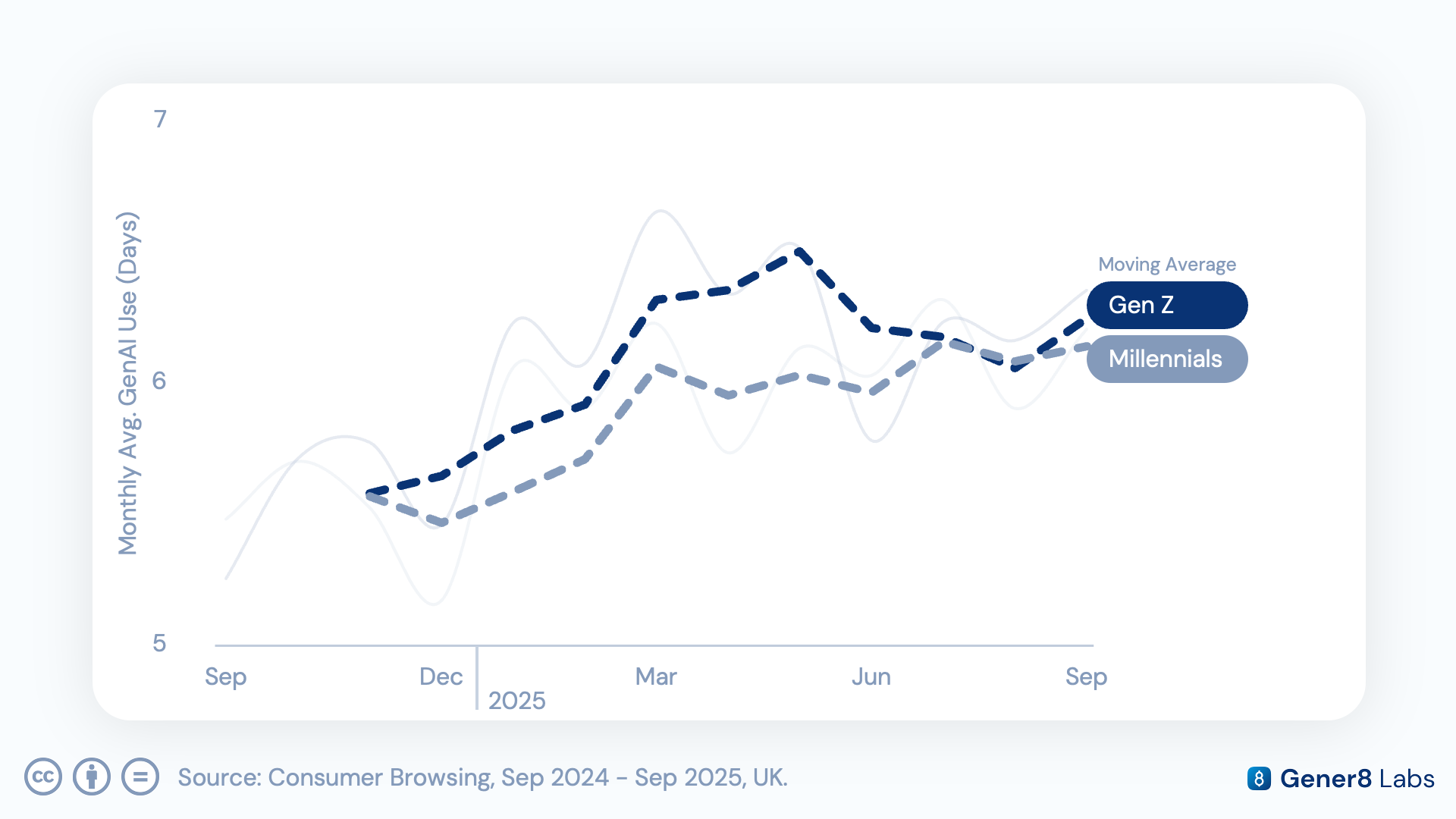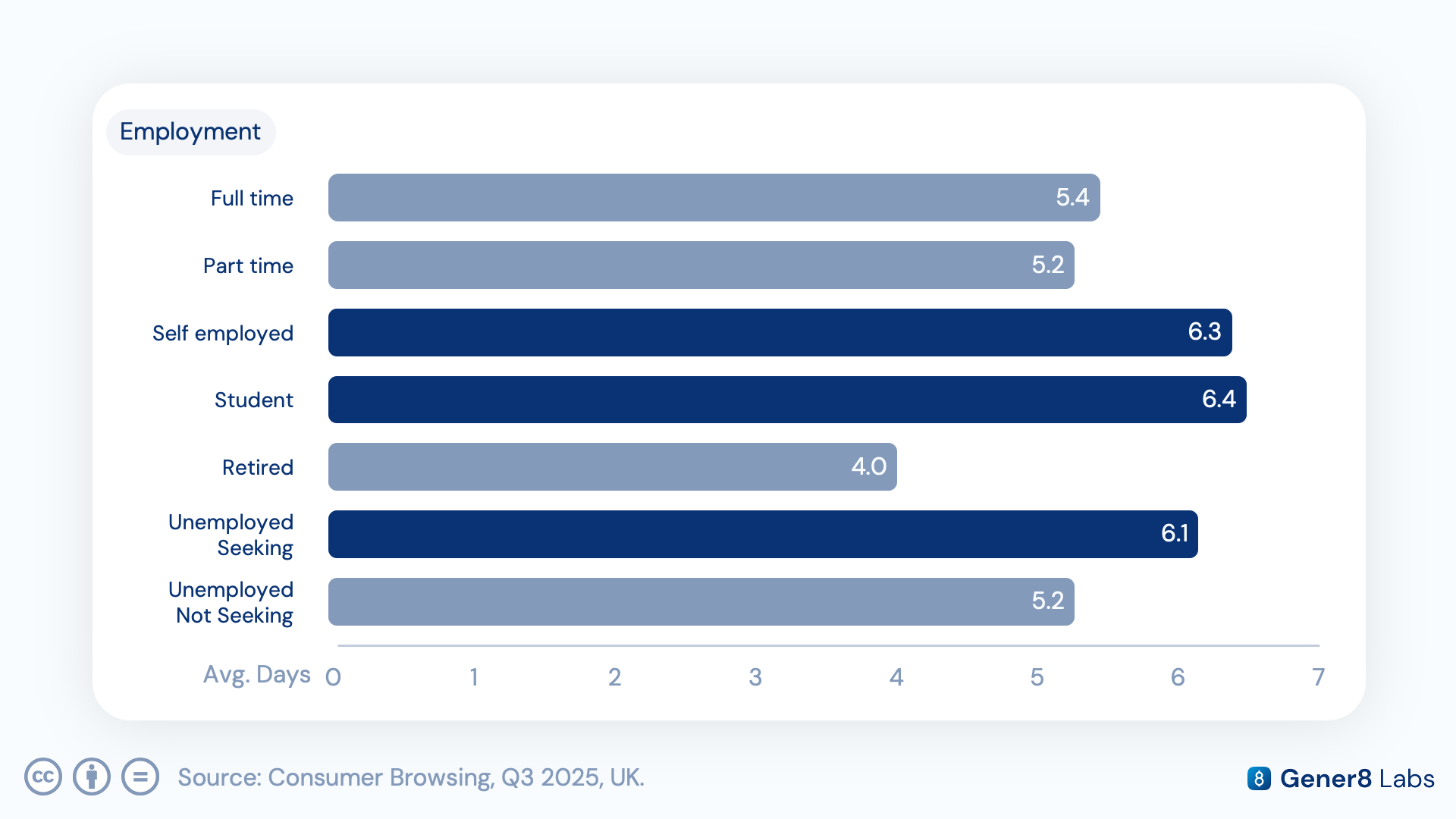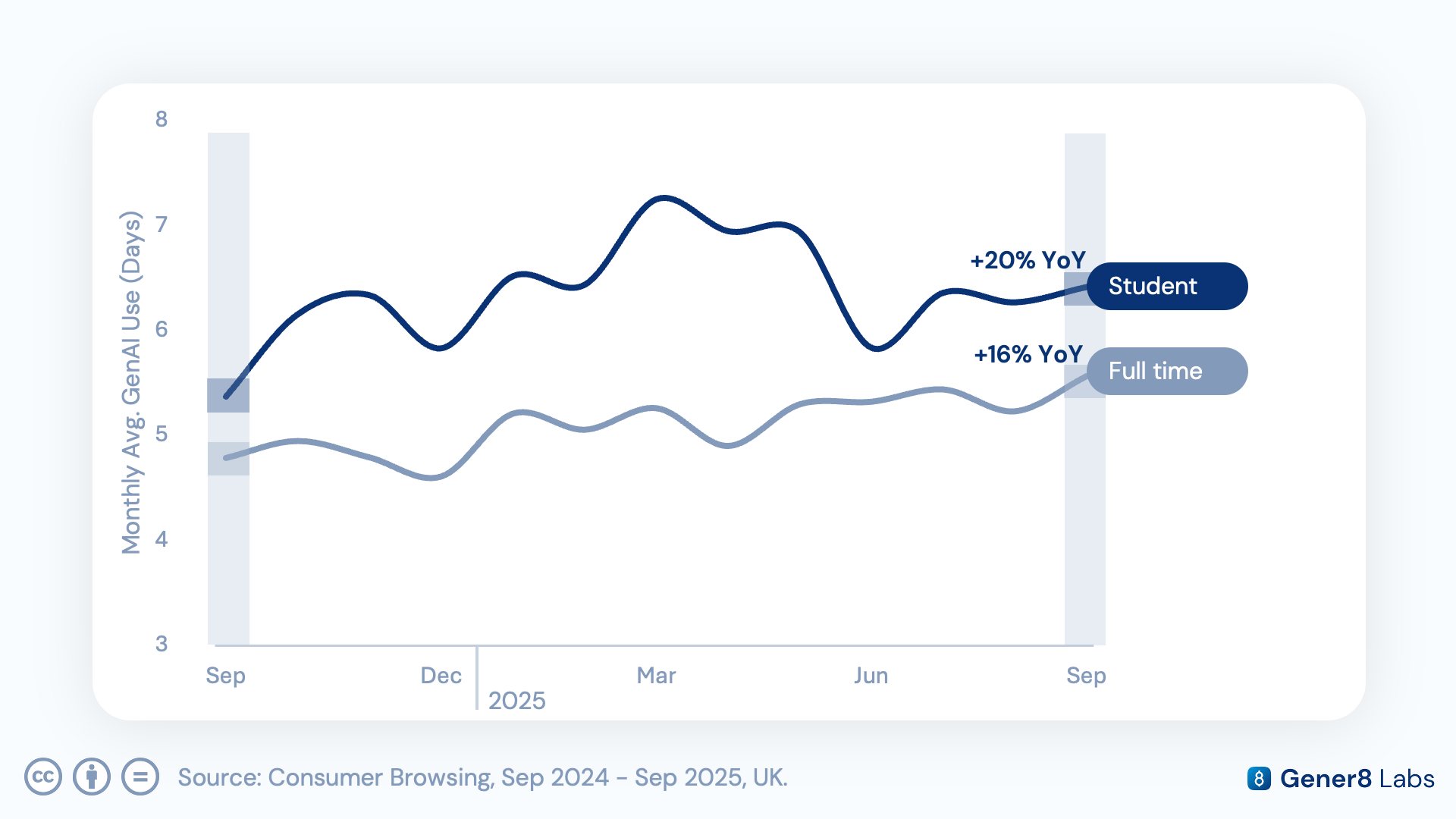
Gener8's data uncovers the demographics behind GenAI usage in the UK
It seems that every piece of news lately, from TV reports to our social media feeds, is about artificial intelligence and how its rapidly expanding capabilities are changing our daily lives at a dizzying pace. Yet, beyond the headlines and the hype, the true measure of a technology's impact is not just its potential, but its penetration into the daily routines of its users.
This article analyses the real-world adoption of GenAI in the UK, drawing on our consumer clickstream data to reveal demographic usage trends for platforms like ChatGPT and Gemini.
Traditional clickstream metrics such as total web sessions or aggregate time spent on a platform can be easily skewed by the behaviour of a small cohort of outliers or ‘power users’. Similarly, widely cited statistics on the percentage of a population that has ‘ever used’ an AI tool fail to differentiate between a single instance of experimentation and regular, meaningful reliance. These metrics measure reach but not resonance. They capture initial contact but not lasting impact. A technology only becomes truly transformative when it evolves from a novelty into a habit.
Our analysis adopted a more nuanced methodology focused on measuring genuine GenAI traction. The core metric of this analysis is the average number of days our users accessed LLM platforms each month. This methodological choice was deliberate. In the world of product analytics and user engagement, metrics that reflect the consistency of use, such as Daily Active Users (DAU), often termed ‘stickiness’, are considered the most reliable indicators of a product's value to its user base. A user who returns to a platform on multiple distinct days within a month is demonstrating a stronger, more consistent need for its services than a user who spends several hours on the platform on a single day and never returns.
Therefore, the ‘average days of use’ metric serves as a powerful proxy for habituation. It filters out the noise of casual, infrequent interactions to reveal which user segments are integrating LLMs into their regular workflows and daily lives. This approach allows for a more accurate assessment of which demographics find recurring, tangible value in these tools. The findings that follow are not just about who is trying AI, but who is building it into their routine, a crucial distinction that provides a clearer signal of the technology's true integration into UK society.
The analysis of user demographics reveals a stark generational chasm that stands as the most significant and defining feature of the current AI adoption landscape.

Our data showed that Gen Z lead GenAI usage at an average of 6.3 days per month, with Millennials following closely behind. When viewed together, these two younger cohorts average almost an entire day (or +18%) more of GenAI usage per month than Gen X users.

This generational divide is not a static picture, it is an accelerating trend. The year-over-year growth in usage frequency is almost entirely fueled by these younger demographics. Our data showed that Gen Z's usage frequency grew by a staggering 21% over the past year. Millennials' adoption rate also saw robust growth of 13%, trending closely with the overall average. In stark contrast, usage across the Gen X cohort remained almost entirely stagnant, rising by a negligible 1% over the same period.
The implications of this trend extend far beyond simple technology adoption statistics. The high-frequency use of GenAI platforms by Gen Z signifies that interaction with these systems is becoming a native digital skill for this generation, much like using search engines or social media was for previous generations. This is not just another tool being added to their digital toolkit - it is a foundational element of how they learn, create, and solve problems.

The findings indicate a clear and positive correlation between a user's level of education and their frequency of engagement with GenAI platforms. The most consistent users are those with postgraduate qualifications, who utilise these AI platforms an average of 6.1 days per month. Individuals with undergraduate degrees were observed to be very close behind, registering an average of 5.9 days of use monthly. This data highlights a distinct behavioural pattern: on average, those who have attended university use GenAI at least one full day (or 17%) more per month compared to those without a university-level education.
Connecting these data points reveals a deeper truth about the drivers of AI adoption. The strong correlation with higher education is not merely a function of digital savviness or a particular demographic's affinity for technology. Instead, it is driven by the very nature of the tasks these users face. The complex, knowledge-intensive work inherent in higher education and subsequent professional roles, such as research synthesis, complex document drafting, data analysis, and coding, provides a fertile ground for high-utility GenAI applications. People with degrees are not using AI more frequently simply because they are more tech-forward, they are using it more because their daily tasks align closely with what AI currently does well. This reframes the adoption narrative from one based on simple demographic traits to a more sophisticated model based on task-based utility.

The analysis of adoption patterns through an employment lens reveals one of the report's most compelling narratives: the highest frequency of use is concentrated among groups who are either operating outside the traditional 9-to-5 employment structure or are actively trying to enter it. Usage is highest among students, the self-employed, and those seeking employment. These cohorts appear to be leveraging AI for specific, high-stakes tasks where the technology provides a direct and tangible benefit to their academic or professional success.
The data shows that students lead all groups, averaging 6.4 days of GenAI use per month, followed closely by the self-employed at 6.3 days and those actively seeking employment at 6.1 days. This pattern of high-frequency use suggests that for these individuals, GenAI platforms are not just a tool for casual exploration but have become a critical co-pilot for navigating demanding and consequential challenges.

Students
Students emerge from the data as the quintessential power-users of Generative AI. They not only represent the highest-frequency user group at 6.4 days per month, but their adoption is also accelerating at the fastest rate, with usage up 20% compared to the previous year. The data also reveals a clear seasonality to their engagement, with usage patterns coinciding with academic calendars and showing distinct peaks during the crucial study and exam periods from March to April. This directly links their AI use to high-pressure academic activities.
Job Seekers
The data identifies those actively seeking employment as another high-frequency user group, averaging 6.1 days of use per month. Their engagement is notably intense, with this cohort using GenAI 15% more than those who are unemployed and not seeking a job. This behaviour is driven by the clear utility AI offers in navigating the modern job market.
Full Time Employees
While full-time employees exhibit a lower overall average usage frequency compared to students or job seekers, their adoption patterns tell a compelling story of steady integration. This group showed significant year-over-year growth of 16%, and the pattern of this growth was broadly linear (seasonality aside), suggesting a consistent and methodical embedding of AI into regular professional workflows.
How can I access this data?
We utilised Gener8's Consumer Browsing and Demographics datasets to deep dive into the GenAi adoption trends in the UK.
Gener8 Labs’ complete data and insights solution empowers media and marketing businesses to find actionable consumer and market insights, using our unique, consented, first party panel data sets that are all connected around one user ID.
Discover how you can power your decisions and gain a competitive edge from our behavioural truth set by contacting us today!



